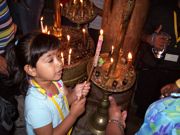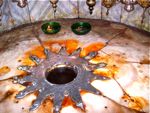An Orthodox message for the planet
22 December, 2009:
 |
 |
 |
Girl light candle inside the Church of the Nativity, Bethlehem |
Martin Palmer writing for the Guardian Online
As Christmas draws nearer many of us recall the nativity scene- the stable, Mary, Joseph, the shepherds, the wise men...
Whilst this is the popular image that Western Christianity evokes, Martin Palmer reminds us that there is a different version of the nativity story that comes from Eastern, Orthodox Christianity.
Writing for the Guardian, Palmer summarises a major difference between the two. Whilst the former tells of Jesus descending miraculously from heaven, the latter, taking place in a cave, focuses on all of creation coming together to make it happen, and goes on to explain how this can have timely significance for all of humanity as we face the challenge of climate change:
By each of us offering what we can, we can make the miraculous happen
 |
 |
 |
Site that marks the "birthplace" of Jesus within the Orthodox partition of the Church of the Nativity, Bethlehem |
"We all know what the nativity scene looks like: Joseph and Mary in a stable, a small town, the shepherds in awe, angels descending and the whole thing a miracle.
Except that for many hundreds of millions of Christians that isn't their story at all.
The scene described above is the western Christian – Catholic and Protestant – version based upon the accounts in the Gospels and a fair amount of imagination.
But in the Orthodox world there's a very different story. In the difference between the two versions we find an insight into different psychologies – psychologies which could fundamentally affect what we do if the Copenhagen summit fails, as many fear it will, to deliver any real answers on how to deal with climate change.
The Orthodox picture of the nativity shows a mountain, miles from any habitation. In the mountain is a cave and in the cave, just Mary, Jesus and the animals. Joseph is either not in the picture at all or is shown on the left hand side, heading towards the cave.
The Orthodox don't follow the account of the birth of Christ in the Gospels. They base their story and paintings on a 2nd century AD text called The Book of James.
In that account, Mary is caught short with the first pangs of childbirth miles from Bethlehem and Joseph puts her into a cave and rides off to find a midwife. Long before he returns, Mary gives birth to Jesus in the cave in the wilderness, accompanied only by the ox and ass.
This could just be one of those interesting pub quiz questions: what is different about the Orthodox and the western stories of Christmas? But it is more than that.
The western Christmas story is about Jesus descending miraculously from Heaven. Humanity, other than Mary, has no role, nor has the rest of creation. Some otherworldly force makes this happen and the world is changed as a result.
But in the Orthodox tradition, as spelled out in a beautiful hymn sung on Christmas Day, the incarnation of Jesus is only possible because every aspect of creation offers something to make it happen. The heavens offer a star; the angels their song; the earth, a mountain; the mountain a cave; the wilderness its grass for the manger; the cattle their warming breath; and humanity Mary's womb.
In this version, God cannot become human without the participation of nature. We – and all aspects of creation – need to participate for the miraculous to occur.
In addressing climate change perhaps we have tried the western view of how the world can be saved. It is as if we are awaiting some external force – international agencies, national governments – to produce a miracle. And they didn't. We relied on others to make the world better and they haven't.
The Orthodox model offers us another way of making the miraculous happen by each of us offering what we can to make it possible.
It will probably take a miracle to save the planet. This isn't just about climate change: that is just a symptom of a much deeper malaise in our relationship to nature – an attitude of greed, stupidity, violence, abuse and neglect.
This is why a month before Copenhagen, nine of the world's major faiths launched their own long-term action plans to protect the living planet, from planting 8.5m trees around Mount Kilimanjaro to greening the hajj, developing ecological purchasing policies for Islam, Sikhism and Hinduism and cutting the Church of England's carbon footprint by 40% by 2015.
They know that by each of us offering what we can, we can make the miraculous happen. By doing everyday things as well as making major new commitments, we can transform the world.
The Orthodox Christmas story tells us that we are the ones who, in partnership with others, can change the world. Heaven lies within us – but only when we act side by side with others, in whom we can also see that glimpse of Heaven on earth."
Read the whole article on the Guardian website
|

